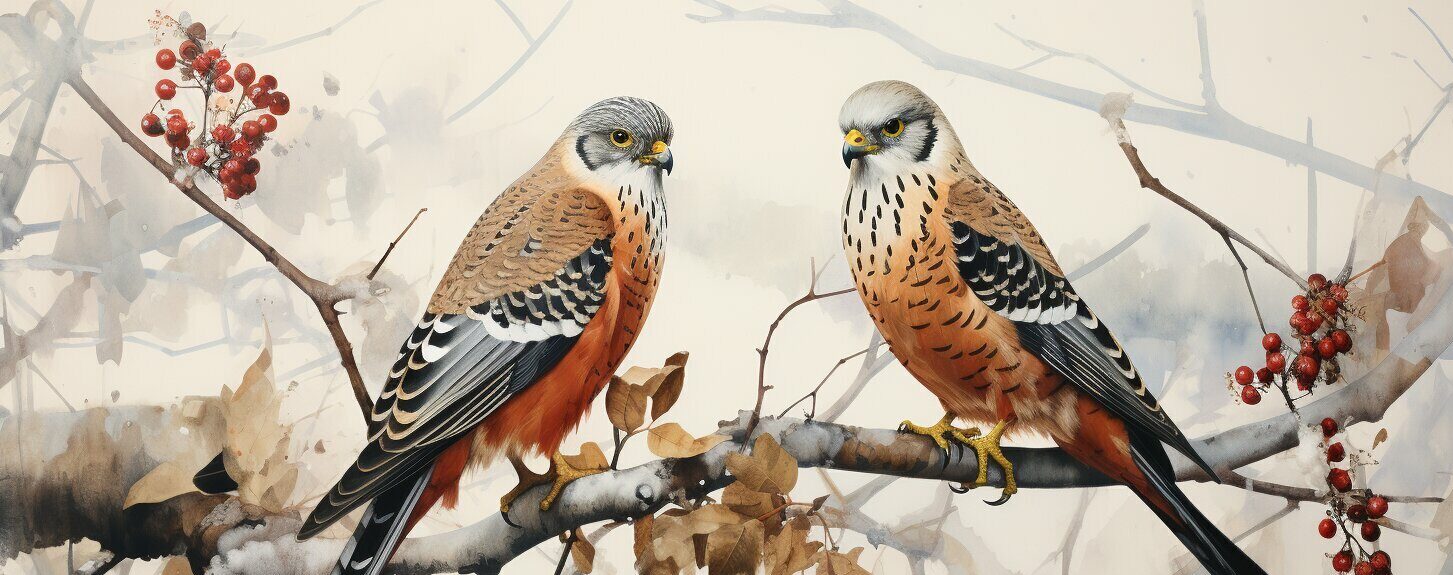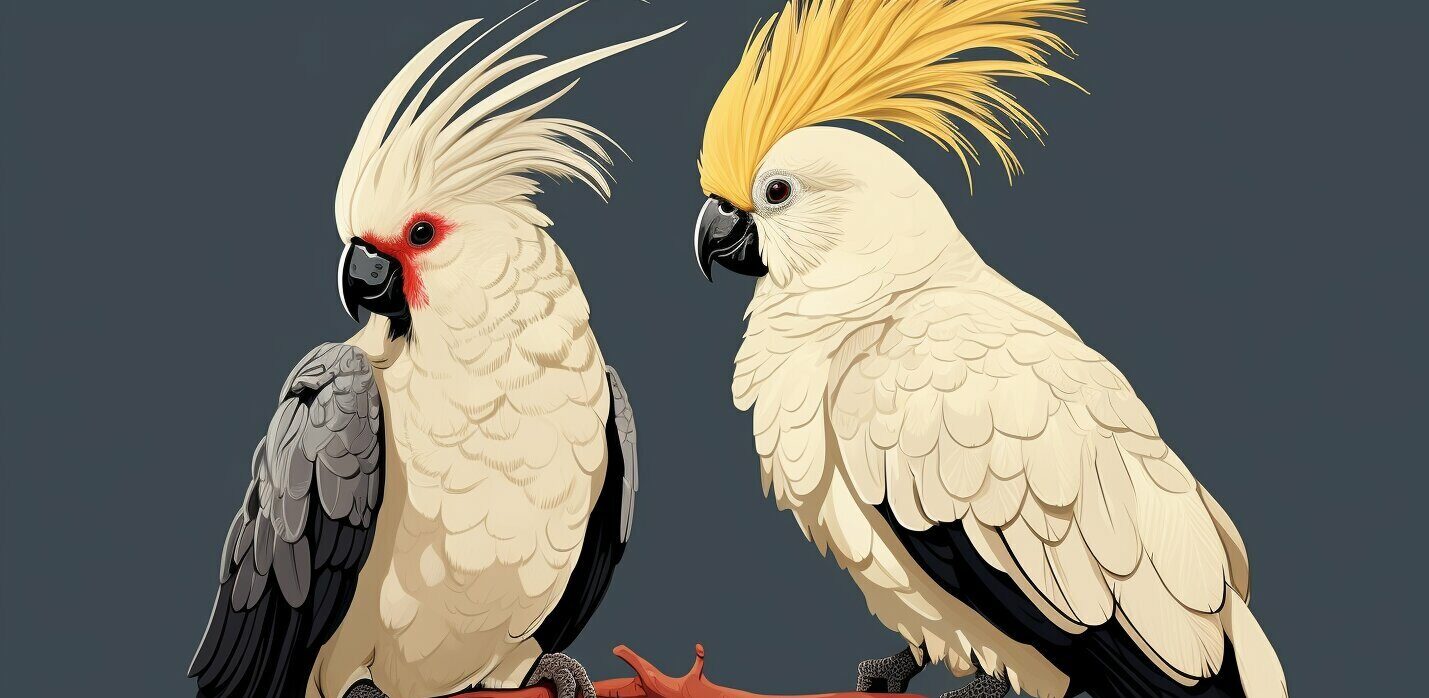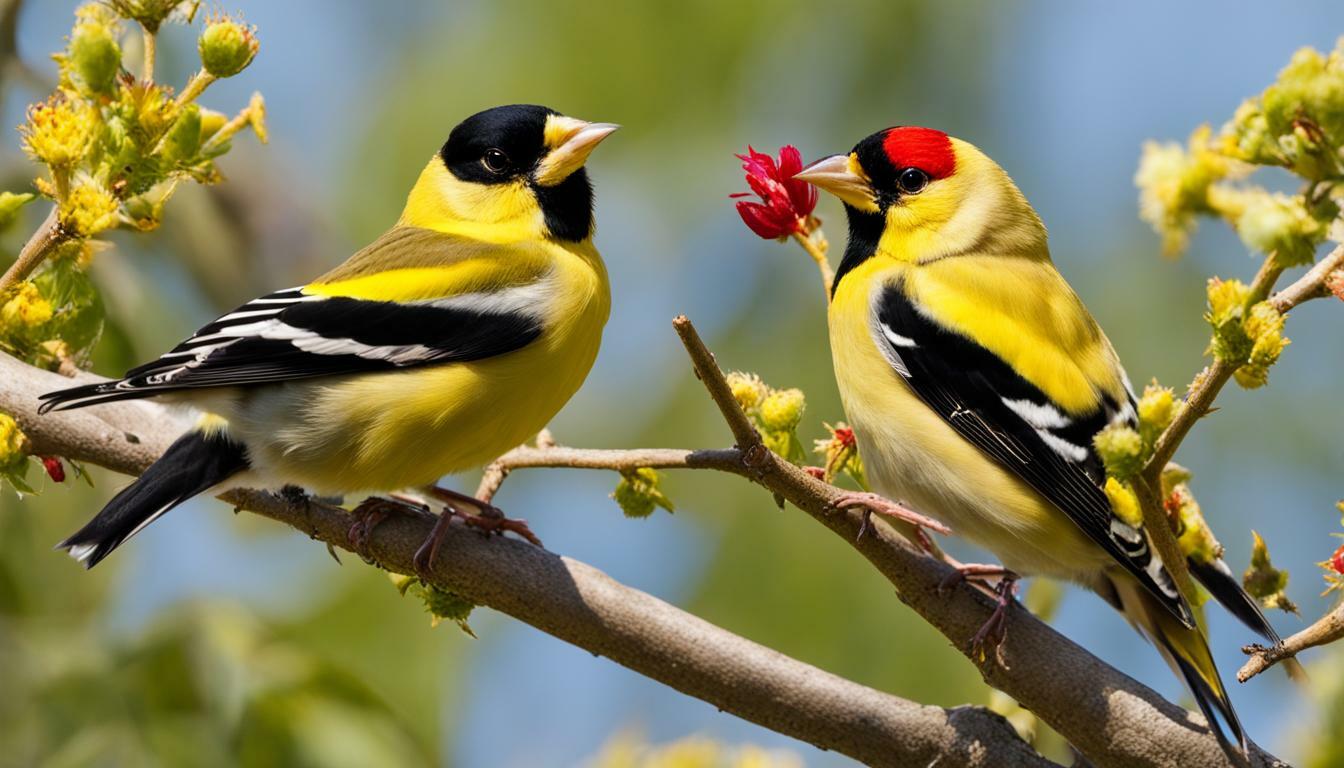When wandering along the coastline, spotting a seagull or pelican is a common and delightful sight, but have you ever thought about the intricate differences that set these two coastal birds apart? Our coastal comparison between seagulls and pelicans will take you on a fascinating journey, unveiling the unique attributes that make these avian species so intriguing and vital for marine ecosystems. With a focus on their behavior, habitat, and feeding habits, a deeper understanding of these remarkable birds will unfold, shedding light on their significance in coastal environments worldwide.
Key Takeaways
- Both seagulls and pelicans play important roles in marine ecosystems.
- Seagulls and pelicans have distinct behavioral and habitat preferences.
- The social dynamics of seagulls differ greatly from pelicans.
- Pelicans exhibit unique diving abilities and collaborative hunting practices.
- Understanding these coastal birds can help in conserving their habitats and appreciating their importance.
Introducing the Coastal Aviators: Seagulls and Pelicans
Coastal environments are home to a diverse array of bird species that contribute significantly to the rich ecosystems they inhabit. Among these feathered inhabitants, seagulls and pelicans are two of the most notable and easily recognized coastal birds. In order to gain a deeper understanding of these fascinating aviators, it’s essential to explore their unique characteristics, behaviors, and roles in the coastal environment. This section will provide a brief overview of seagulls and pelicans as key coastal aviators and set the foundation for deeper comparisons and discussions in the following sections.
Seagulls are medium-sized, predominantly white birds with a reputation for their bold and opportunistic feeding habits. With over 50 species found across the globe, they exhibit a range of adaptations that enable them to thrive in diverse coastal habitats. Some of the most notable aspects of seagull behavior include their opportunistic feeding strategies, sociable nature, and intricate communication methods.
On the other hand, pelicans are larger birds, easily recognizable by their distinctive bills with a pouch used for feeding. There are eight species of pelicans in the world, and while they share some similarities with seagulls, they display a number of unique characteristics and behaviors. Pelican behavior is particularly intriguing due to their group hunting strategies, cooperative fishing techniques, and the art of diving for their prey.
| Characteristics | Seagulls | Pelicans |
|---|---|---|
| Size | Medium-sized birds | Larger birds |
| Bill size and shape | Smaller, hooked bills | Long bills with a pouch |
| Feeding habits | Opportunistic feeders, foraging | Diving for prey, cooperative fishing |
| Social behavior | Sociable, form large flocks | Group hunters, cooperative |
These key differences between seagulls and pelicans contribute to the intrinsic fascination of coastal bird comparisons. It’s important to note that both of these bird species play vital roles in the marine ecosystem, aiding in the maintenance and balance of diverse coastal habitats. Gaining an understanding of their unique behaviors and characteristics will not only deepen our appreciation for these birds, but also underscore the need for continued conservation efforts to protect and preserve their habitats.
Understanding Seagull Behavior and Habitat
Seagulls, being highly adaptable coastal bird species, exhibit fascinating behavior and habitat preferences that have a significant impact on their survival along coastlines. An in-depth understanding of their social dynamics, nesting habits, and migratory patterns provides valuable insights into their way of life and the role they play in marine ecosystems.
The Sociable Nature of Seagulls
Seagulls are known for their gregarious lifestyle, often found congregating in large groups or flocks. Their social interactions play a crucial role in their survival, as they rely on teamwork for protection, food sourcing, and raising their young. Communication amongst gulls often includes both vocal and nonvocal cues, such as calls, displays, and body postures, enabling them to share information and establish a hierarchy within their group.
Seagull Social Behavior Benefits:
- Increased protection against predators due to increased vigilance and numbers
- Better foraging opportunities through cooperative feeding strategies
- Enhanced survival rates of chicks due to shared parenting duties
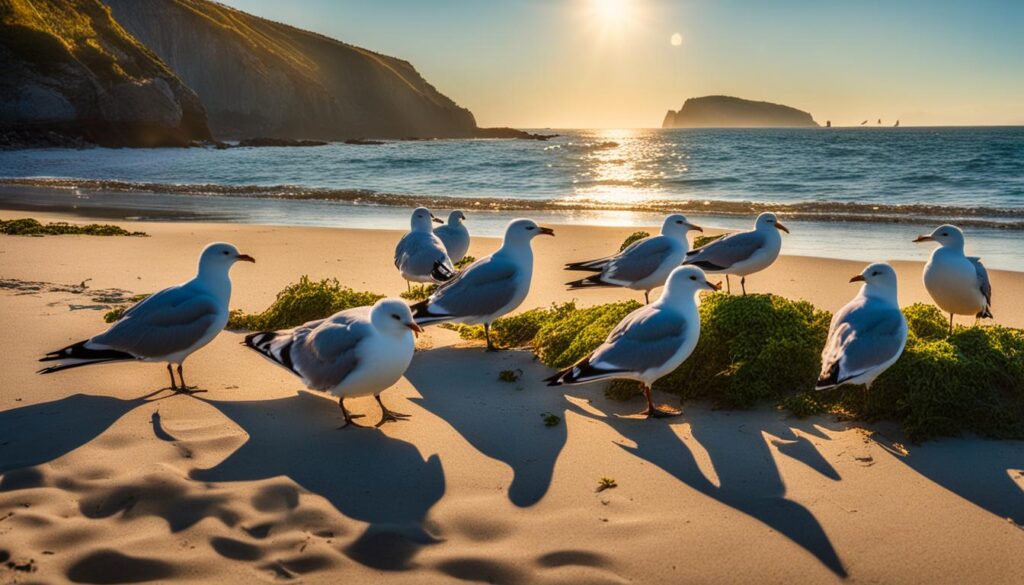
Nesting and Migratory Patterns of Seagulls
Seagull nesting habits vary among species, but they generally tend to establish their nests in coastal areas, islands, or inland water bodies, where they lay one to four eggs per clutch. Seagulls often reuse or build on previous nesting sites, creating a micro-habitat where generations of gulls raise their young. While some seagull species can be resident breeders and remain close to their nesting grounds throughout the year, others may migrate long distances in search of better food and breeding conditions.
| Seagull Species | Nesting Habits | Migration Patterns |
|---|---|---|
| Herring Gull | Builds nests on cliffs, roof ledges, and flat ground, sometimes forming colonies | Migrates short distances, with some groups staying within their breeding range year-round |
| California Gull | Nests in colonies on islands in lakes and other inland water bodies | Migrates to coastal areas during non-breeding season |
| Western Gull | Prefers to nest on rocky coastlines and offshore islands in colonies | Some populations stay within their breeding range, while others migrate south during winter |
By understanding seagull behavior and habitat adaptations, we can better appreciate these resourceful coastal aviators and their incredible adaptability. By doing so, we can further develop effective conservation measures to ensure their continued presence in the diverse marine ecosystems they call home.
Diving Into Pelican Behavior and Habitat
Pelicans are renowned for their extraordinary behavior and adaptation to diverse coastal environments. This section will explore the various aspects of pelican behavior and their preferred pelican habitat to understand their daily activities and survival strategies.
Pelican Social Dynamics and Communication
Unlike seagulls, pelicans are more reserved and display a highly organized social structure. They often live in large colonies and depend on each other for protection and communal nesting. Pelicans communicate using a range of vocalizations and body language such as bill clapping and wing flapping, which play crucial roles in maintaining harmony within the group.
Habitat Preferences and Environmental Adaptations
With their primary focus on coastal regions, the eight pelican species can inhabit a wide range of environments, including estuaries, lagoons, and saline lakes. The American White Pelican dwells in freshwater wetlands, such as marshes and swamps located in North America, while the Brown Pelican prefers saltwater environments like coastal shores and rocky cliffs. These diverse habitats allow pelicans to thrive amidst various nutritional resources and weather conditions.
Nesting and Breeding Habits
Pelicans exhibit unique nesting and breeding habits, occupying territories close to water resources to ensure easy access to food and safety from predators. They build nests with sticks and twigs, often positioned on the ground, creating protected nesting areas. This communal nesting approach fosters a strong bond amongst colony members and plays a significant role in the survival of their offspring.
Migratory Patterns of Pelicans
Migration in pelicans is typically influenced by seasonal changes, which affect local food availability. This dependence often prompts them to migrate long distances in search of suitable habitat and optimal feeding conditions. The table below illustrates the migratory patterns of various pelican species:
| Pelican Species | Migration Route | Migration Distance |
|---|---|---|
| American White Pelican | Central United States to Southern coasts | Up to 3,000 miles |
| Brown Pelican | Western United States to Central America | Up to 2,200 miles |
| Peruvian Pelican | Peruvian coasts to Northern Chile | Up to 1,500 miles |
In summary, pelicans demonstrate fascinating behavior and habitat preferences that allow them to thrive in various coastal environments. Their social dynamics, habitat selection, nesting, and migratory patterns significantly influence their daily activities and survival strategies.
Seagull Feeding Habits: Masters of Opportunism
Seagulls, known for their opportunistic and versatile feeding habits, have been able to thrive in diverse environments. Their dietary choices range from natural food sources like fish and invertebrates to scavenging on human leftovers. In this section, we will explore the various foraging techniques of seagulls and how human interaction has impacted their diet.
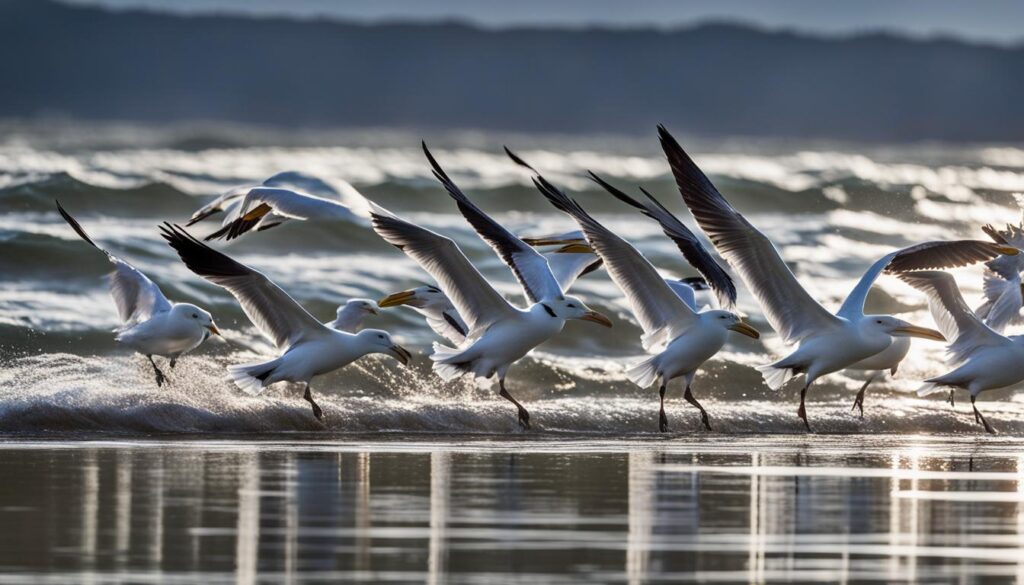
Foraging Techniques of Seagulls
Seagulls employ a wide array of foraging techniques to obtain their meals, displaying great adaptability and resourcefulness. Here are some common strategies used by these coastal aviators:
- Scavenging: Seagulls are known to extensively scavenge for food in urban environments, taking advantage of discarded food and waste from humans.
- Predation: These birds are adept predators, often preying on small fish, crustaceans, and other marine invertebrates.
- Kleptoparasitism: Seagulls may resort to stealing food from other seabirds when the opportunity presents itself.
- Aerial diving: In search of fish, some seagull species dive into the water from considerable heights with remarkable precision.
Human Interaction and Its Impact on Seagull Diet
As coastal areas experience increased human development, the lives and dietary preferences of seagulls have been significantly impacted. Below, we examine some of the consequences of human-seagull interaction.
| Urban Environments | Tourism |
|---|---|
| Seagulls readily scavenge in urban areas, finding abundant food sources in the form of discarded human waste and leftovers from restaurants. | Tourist hotspots often provide easy access to food for seagulls, either through direct feeding by tourists or as a result of increased litter in popular areas. |
| In cities with landfills, seagulls are known to congregate in massive numbers, causing disruptions to the natural dynamics of local bird populations. | Tourism can inadvertently contribute to changes in seagull behavior, as these birds become more accustomed to human presence and more aggressive in their quest for food. |
While seagulls have shown an impressive ability to adapt their seagull feeding habits to changing environments and sources of food, it is crucial to recognize the potential human impact on seagulls and their ecosystems. To ensure a healthy balance within coastal ecosystems, continuous efforts should be made to minimize the adverse consequences of human activity on bird populations.
Pelican Feeding Habits: The Art of Diving for Dinner
Unlike seagulls, pelicans are known for their unique and highly skilled diving strategies when hunting for food, setting them apart from their coastal avian counterparts. As one of the main aspects of their behavior, it’s essential to understand and appreciate the pelican feeding habits to truly grasp their place in coastal ecosystems. Furthermore, their diligent and cooperative group hunting strategies reflect a sophisticated and well-coordinated approach to sustenance.
Group Hunting Strategies of Pelicans
One of the distinguishing aspects of pelican feeding habits is their remarkable teamwork and synchrony during group hunting. Several pelican species, like the Brown Pelican, have evolved to create hunting strategies that maximize the efficiency and effectiveness of their food-gathering process. Employing a combination of communication and coordination, they showcase an ability to work in unison, unlike many other coastal bird species.
When engaged in group hunting, pelicans will often align themselves in a semicircular or linear formation, herding schools of fish towards shallow waters where they easily pluck their prey from the surface. As fish are driven closer together, the pelicans will then synchronize their dives, plunging headfirst into the water with their large pouches open to capture as many fish as possible.
- Formation creation: Pelicans work together to create strategic formations that help corral fish.
- Herding fish: Using their formations, they push schools of fish into shallow waters.
- Synchronized diving: Pelicans coordinate a simultaneous dive to snatch their prey, ensnaring fish in their beaks.
Not all pelican species utilize the same collaborative hunting strategies, with certain species preferring to forage individually. However, those that do engage in group hunting demonstrate a level of cooperation and sophistication that sets them apart from other coastal birds.
| Pelican Species | Group Hunting Strategies |
|---|---|
| American White Pelican | Often hunts in sizable groups, sometimes forming a semi-circle and using coordinated wing movements to drive fish into shallower waters. |
| Brown Pelican | Typically forages in groups, synchronizing their dives to capture fish more efficiently. |
| Great White Pelican | Hunts in large groups that work together, using their wings to create strong currents that move schools of fish towards shallow waters. |
| Australian Pelican | Occasionally forages in groups, working together to herd fish and diving in tandem to catch prey. |
In conclusion, pelicans display an impressive level of cooperation and adaptability in their feeding habits. From the different group hunting strategies employed by various pelican species to their unique diving abilities, understanding these behaviors sheds light on how these coastal birds have evolved and continue to thrive in their habitats.
Conclusion
In this coastal comparison of seagulls and pelicans, we’ve discovered that these two avian species exhibit unique behaviors and preferences in their respective habitats. Despite sharing the coast as their home, their feeding habits, social dynamics, and migratory patterns significantly differ.
Seagulls excel as opportunistic feeders, thriving in a variety of environments, whereas pelicans utilize impressive diving techniques and group hunting strategies to catch fish. This distinction in feeding approaches highlights the innate adaptability of these coastal birds. Furthermore, their habitats and behaviors provide valuable insights into the integral role these species play in maintaining marine ecosystems.
As we continue to appreciate and study the fascinating world of seagulls and pelicans, it’s essential to recognize the importance of preserving their habitats for future generations. By understanding and respecting the differences and similarities between these two coastal aviators, we can work together to protect and conserve the diverse marine environments they call home.
FAQ
What are the main differences between seagulls and pelicans?
Seagulls and pelicans differ in size, appearance, behavior, and feeding habits. Seagulls are smaller and more sociable, while pelicans are larger and known for their unique diving abilities and cooperative hunting techniques.
How do seagulls and pelicans impact coastal ecosystems?
Both seagulls and pelicans play important roles in coastal ecosystems, such as controlling fish and invertebrate populations, dispersing seeds, and helping to break down organic matter. Their presence also serves as an indicator of ecosystem health and vitality.
How do human activities affect seagulls’ feeding habits?
Human activities, such as urbanization and tourism, can greatly impact seagull feeding habits by providing easy access to food sources like trash bins and discarded food. This has led to some seagull populations becoming more dependent on human activity and less reliant on their natural foraging abilities.
What are some examples of seagulls’ opportunistic feeding habits?
Seagulls are known for their opportunistic feeding habits, which include scavenging at landfills, stealing food from other birds, and taking advantage of human food sources. They also have diverse foraging techniques, such as aerial hunting, stalking prey on the ground, and searching for food in shallow water or on the shoreline.
How do pelicans hunt collaboratively?
Pelicans hunt collaboratively through a well-coordinated group effort known as cooperative hunting. They work together by herding fish into a concentrated area, making it easier for individual pelicans to dive and scoop up their prey. This teamwork and synchrony allow them to efficiently capture large quantities of fish.
Do seagulls and pelicans share the same habitats?
While both seagulls and pelicans primarily inhabit coastal environments, their specific habitat preferences may vary depending on factors such as food availability, nesting sites, and migratory patterns. Seagulls tend to be more widespread and adaptable, while pelicans may be more selective about their preferred habitat.
Are seagulls and pelicans considered threatened or endangered species?
Although many seagull and pelican species are not currently considered threatened or endangered, habitat destruction, pollution, and other human activities can pose significant threats to their populations. It is crucial to continue studying and protecting these coastal bird species to maintain healthy marine ecosystems.
 Skip to main content
Skip to main content
